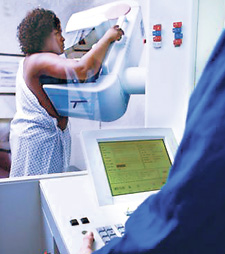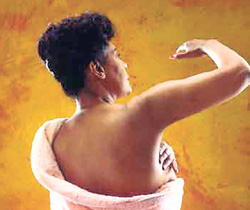It may be that scores of women around Sri Lanka are fingering their breasts nervously at this moment to ascertain whether they can feel any unwelcome lumps.
I know three such, all of them about 30 years younger than I, who did discover lumps and were unutterably relieved to find they were benign or harmless.
With the approach of my 85th birthday, I really thought I’d sailed past those perilous seas into calm waters, but I did continue to look for lumps.
And then on Sunday, January 24, I did discover one, although I half hoped it was my imagination. I kept mum about it until January 26. when I asked a doctor friend of mine whether she would be good enough to have a look at my left breast and tell me whether the offending lump really existed.
She kindly came over, examined me and said, “Yes, there definitely is a lump and you’d better have it out quickly, even though it’s probably a harmless one, as I can’t feel any glands.”
The two questions that I am most frequently asked now are: “Does breast cancer occur in women over 80?” and, “How did you find out that you had a lump?” I’ve learned that breast cancer is by no means uncommon among us oldies – both my surgeon and an Oncologist confirmed this.
The compensating factor is that among us old people, the cancer develops at a much slower rate than it does in the younger age group of 40s and 50s.
“It’s not so virulent,” said my surgeon.
As to how I discovered it, the habit of feeling my breasts for lumps at bath time was routine with me – not that anyone in my immediate family had suffered from breast or any other cancer, but because there’s so much publicity given today to the need to look for lumps.
However, my Oncologist emphasized that what every woman over 40 should do, is to have a Mammogram taken once a year, because by that means even a small ‘seed” is discovered long before it grows into an identifiable lump and if it is malignant or cancerous, early treatment is so much more effective.
People make a big thing of a Mammogram being a painful procedure.
May I state that while it does hurt when a lever is clamped down on your breast, the pain is of momentary duration, just a minute or two, and is surely preferable to the suffering that can be caused by a full-blown cancer?
I saw a reputed surgeon on January 27. He examined me and murmured, “Yes, there is definitely a lump.” He sent me for a Mammogram and a fine needle biopsy of the lump at a private hospital. The doctor who looked at my Mammogram ordered an Ultra-Sound scan as well. As for the fine-needle biopsy, I hardly felt the prick, although it had to be done a second time. The report was that I was clear and I felt pleased.
Since the fine needle biopsy cleared my lump of malignancy, my surgeon, Dr. G., recommended a lumpectomy the very next day. `Lumpectomy’ means a fairly simple surgical procedure whereby the lump is removed under a local anaesthetic. I went home in a couple of hours, having been given the “lump” (floating in a bottle of spirits) to be handed in for a biopsy.
We then informed my eldest daughter who happens to be an Oncologist practising in New Jersey, USA. Ranmali was on the ‘phone to me immediately. I told her the fine needle biopsy had cleared me, but she spoke candidly and was of the opinion that the lump was very likely to be malignant, as the fine needle procedure doesn’t always give an accurate result.
This deflated me somewhat. In the event, she was right and even before we got the biopsy report confirming Ranmali’s suspicion, she arrived here in person and accompanied me on my next visit to Dr. G. He read the biopsy report and discussed what options I had.
 |
| An annual Mammogram is recommended for those over 40. Pix courtesy getty images |
It was a huge relief to me and to all the family that Ranmali was present to guide us, in discussion with Dr. G. I was to have a full mastectomy of the left breast, with removal of lymph nodes. It all seemed unreal. I wasn’t at all nervous, but felt as if it were happening to someone else.
I had my breast removed by Dr. G., under general anaesthesia on February 8, in the late evening – this is what is called a Mastectomy.
Thirteen lymph nodes too were removed. When I regained consciousness I felt no pain whatsoever.
It was nice, the next morning, to have the ministrations of a most competent nursing attendant who gave me a wonderful sponge from head to toe. Nicer still, was the appetizing breakfast of stringhoppers with pol-sambol and a curry. I guessed I was on pain-killers and anti-biotics when the nurses brought round pills of various shapes & hues and I am happy to declare that at no point did I have even a twinge of pain.
I was able to get out of bed and go to the toilet on that first day. I came home on the evening of February 11 and was able to come to the computer after dinner to send off an e-mail to Ranmali (who had gone back by then) and to my other children abroad, assuring them that I was doing fine.
While in hospital, I had a tube draining fluid from the wound into a bottle. This was taken out the day before I left, but on two subsequent visits to Dr. G., he had to drain fluid again – this procedure, again, is hardly felt. I had stopped taking the pain-killers quite early on, with the surgeon’s permission
On February 21, with the surgeon’s blessing, I travelled to Kandy by car and on the 25th I was able to sit through six solid hours of the Peradeniya University’s General Convocation 2009 at which my granddaughter was among the graduands.
Back in Colombo, I resumed my normal life.
I’ve been to see the Oncologist, Dr. A., with whom Ranmali had spoken when she was here. He was as satisfied with my progress as my surgeon had been. He asked me whether I had started taking the pill, `Femara’, which he knew Ranmali had brought me and he asked me to continue with that for a few years.
No chemotherapy and no radiation. No dietary restrictions. I should see him every four months.
Ranmali gave us a very lucid account of my diagnosis and prognosis at a family conclave held round my dining table one day. I’d like to share with you some of what she said from a medical viewpoint, because it might be helpful.
Although it is hoped that the removal of the breast lump would ensure a cure, sometimes the cancer “returns” because there are microscopic cells which have already escaped. These are not detectable and remain dormant, but can start growing at any point in time and show up as “metastases” in any part of the body. This could happen up to 30 years later in slow-growing situations, and much sooner in others.
Four common factors are considered when assessing what the risk is and what can be done to prevent it.
(1) Is there lymph- node involvement? (In my case, 2 out of 13 lymph nodes that were removed, had cancer cells – but the plus point is that these lymph nodes were taken out).
(2) The size of the tumour: My lump was 2.5 cms. In general, if any tumour is more than 1 cm. some kind of treatment is recommended.
(3) Was the tumour sensitive to Estrogen? This is measured by what is called the Estrogen Receptor and Progesterone Receptor. Mine were highly positive – 99% and 93% - and this is a GOOD thing for two reasons.
The first is that in general, people with ER and PR positive tumours, have a better prognosis. The second is that because these tumours are sensitive to Estrogen (that is, Estrogen can make the tumour grow), by blocking the Estrogen, any microscopic cells that may be around can be “killed”. This is the single most effective way one can prevent breast cancer from recurring.
(4) A check is made for a protein called the HER2 protein. This was negative in my case, which was also a good sign as people with HER2 positive have a higher risk of recurrence.
I understand that since two of the lymph nodes that were removed were cancerous, cancer cells could be lurking undetected in some part of my body. In younger people, this would mean chemotherapy as well, but it has been found that in older people with ER positive tumours, the risk of recurrence is reduced by almost 50% with these Estrogen Blockers – I should take the tablet I am on, “Femara”, for 5 years. In general, older people have slower-growing cancers. Ranmali explained to me that I don’t need radiation since I had the mastectomy, but if my tumour (or lump) had been over 5 cms, or if more than 4 lymph nodes were positive (high risk), then Radiation would have been indicated.
The down-side of the pill, Femara, is that it promotes Osteoporosis and X-rays have shown that I already suffer from this condition. In order to counteract this, I am also on a weekly pill called Osteofos 70, along with two tablets of calcium (Regucalcium) which I take daily.
Overall, my prognosis is fairly good, but, as Ranmali says, with cancer one never knows. One other point she stressed is that a positive outlook is always a plus point. I thank God that I am naturally a resilient type and I have plenty of interests to take my mind off disease. With cancer spreading around the world like global warming, I would add that having an Oncologist in the family is a big bonus! |



